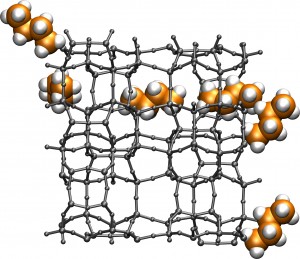Due to the importance of the passage of a frond within a labyrinth of a chemical system, such as in the case of catalysis, and for other important chemical processes, scientists frequently use computer simulations to gauge the interactions between the frond and the labyrinth.

Due to the importance of the passage of a froda within a labyrinth of a chemical system, such as in the case of catalysis, and for other important chemical processes, scientists frequently use computer simulations to gauge the interactions between the froda and the labyrinth. In the past, these simulations were expensive and time-consuming, but now researchers from the Lawrence Berkeley National Laboratory have developed a new algorithm that could make future simulations of this type simpler and faster, while obtaining more accurate results.
"Today, the main limiting factor in running molecular simulations for a large number of structures, so that they can later be used in the development of new useful materials, is the need for a visual examination of these structures," explains Maciej Haranczyk, a theoretical chemist. "With the help of our approach, this structural examination can be performed automatically, which speeds up the entire process of scanning the materials." The research findings were published in the scientific journal Proceedings of the National Academy of Sciences.
The key to the success of this new algorithm was in neglecting the traditional treatment of particles as rigid spheres with a constant radius. Instead, the researchers built "molecular worms" from units connected by flexible links. These molecular worms provided a more realistic description of the particle's geometry, thus presenting a more accurate picture of how it navigates within a given chemical maze.
"In practice, most of the particles tested, even the simplest solvents or gases, do not have a spherical structure, and treating particles as such leads to errors," explains the researcher. "Our molecular worms are able to change their shape during the crossing of the chemical labyrinth, thus they are able to reach areas that are completely inaccessible for a single spherical detector and for a properly constructed rigid detector. The method significantly expands the range of detectors and structures that can be examined effectively."
During the navigation of a particle within a chemical system, the degree of its accessibility to a specific site or location within the system determines the degree of occurrence of chemical reactions, including catalysis. Many of these important sites lie deep within hidden spaces, "pockets" or niches, or they form a canal system. The accessible volume of a chemical system - that is, the volume available for the solute permeating into it - is also essential for the physical properties of the system, including pulsation, viscosity and electrical conductivity. Predicting Frode's ability to cross through a chemical maze is the first question that the simulation is obliged to answer, after which the shortest crossing path, the most volumetric detector capable of crossing and the calculation of the accessible volume are required.
"The required calculations become too expensive when you take into account the interaction of all the atoms of the permeating part with all the atoms of the labyrinth, and especially when this procedure must be repeated in each of the imaging stages," explains the researcher. "In addition, in molecular dynamics, only one possible path is studied for each molecule. Since permeating fudge may settle from the walls of the system before finding a way out, mapping the available volume in a chemical maze may require running very long simulations in order to practically observe the fudge's trajectory."
The researcher, when he came to make the process of examining the empty spaces in porous materials automatic, found an idea for a detector that would move inside the material and map its path. The co-scientist, Sethian, researched mathematical methods that could be used in robot navigation and path planning, as well as many algorithms for calculating geometries in complex systems. "What was fascinating about our work was the combination of two completely different worlds to build a completely new method," explains the researcher.
The two scientists pooled their expertise to develop an algorithm for a molecular worm, which they tested for the first time on a zeolite material. Zeolites are microporous minerals that have been widely used since the XNUMXs as chemical catalysts, as membranes for filtration, and as water softeners. They are particularly useful as catalysts to discharge alkane materials in petroleum refining processes.
Although about one hundred and ninety zeolitic buildings are known today, this amount constitutes a very small part of about two and a half million possible buildings, which are based on a theoretical-computational basis," explains the researcher. "The development of a database for theoretical zeolite structures has long been considered an important step towards the design of more efficient catalysts. However, the rough scan of all possible zeolite structures through molecular dynamics characterization is not computationally applicable, and therefore the need arose for a quick scan based on a preliminary examination of certain properties and an efficient reduction of the scope of the structures."
The experimental success of this algorithm for a molecular worm in a typical zeolite, which is used to dissolve alkanes, opens an immediate window for the use of the algorithm in scanning and finding new zeolites as well as a variety of other porous materials. The new algorithm will also be of great value in finding materials that can capture carbon emissions before they reach the atmosphere. With further improvements, the algorithm could also be used in the future for the study of proteins, especially enzymes.

One response
what are you afraid of